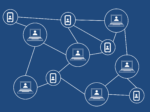
In a world where technology evolves at breakneck speeds, a seismic shift is occurring in how we access and manage our daily lives. At the forefront of this change is Gen Z, those aged 12-27 today, who are spearheading a revolution in digital identity and payments.
A recent PYMNTS study reveals a striking generational divide: 79 percent of Gen Z shoppers prefer digital wallets, compared to a mere 26 percent of baby boomers and seniors. This isn’t just a trend; it’s a fundamental reimagining of how we interact with the world around us.
Digital payment solutions such as Apple Pay, Google Wallet, Brazil’s Pix, and PayPal are outpacing traditional payment methods by offering a seamless and secure “tap to pay” or “scan QR code to pay” experience that resonates with the digital-native Gen Z.
But this shift extends far beyond payments.Young adults are carrying their entire lives in their digital wallets, including driver’s licenses, identity cards, library cards, shopping rewards, vaccination records, and even academic credentials. The message is clear: if you’re still fumbling with a leather billfold, you’re not just behind the times – you are unfashionable.
This digital transformation raises critical questions about identity, security, and user control in our increasingly connected world.
The Dark Side of Digital: Balancing Convenience with Security
The convenience of digital wallets, however, comes with its own set of concerns.
As we consolidate vital data, documents, and digital money into a single digital space, we inadvertently create a tantalizing target for cybercriminals. The risks of being hacked on an unsecured network or falling victim to a sophisticated phishing scam that grants unauthorized access to our mobile devices are more than just hypothetical scenarios – they’re real threats in our interconnected world.
These concerns aren’t limited to individual users. Even government initiatives to digitize identification are facing scrutiny. Take, for example, the California DMV’s recent rollout of a mobile driver’s license (mDL). While seemingly a step towards modernization, the Electronic Frontier Foundation has raised alarm bells, citing “significant privacy and equity concerns.”
This caution is particularly pertinent given the rise of age-verification laws that potentially impede internet access and the glaring absence of comprehensive consumer data privacy legislation. As we rush towards a digital-first future, we must ask ourselves: are we adequately prepared to protect our digital identities?
Unifying the Digital Self: The Path to Seamless Verifiable Credentials
In today’s digital landscape, we’re drowning in a sea of passwords, security protocols, and fragmented identity systems. The frustration of managing multiple access points to online apps, services, and information sources has reached a tipping point. The tech industry needs to develop a universal identity verification standard, and we may be on the cusp of achieving it.
For example, the latest version of a new model called the Verifiable Credentials Data Model V2.0 was just published by the W3C Working Group in early July. It is quite flexible and allows for different formats, like JWT and JSON-LD, different digital signature algorithms, and different methods of decentralized identifiers (DIDs). However, the data model is not enough for standardization. Protocols like OID4VC and DIDComm are being developed for this purpose.
Interoperability is maybe the biggest challenge on this topic, and one to watch for this quality is the EUDI Wallet, a European R&D project for building an open-source wallet that is compatible with mDL and multiple flavors of verifiable credentials (VCs).
As major players like Apple, Google, and Microsoft, work towards finalizing their digital identity protocols, we’re seeing a convergence of various methods, from private and verbal credentials to QR codes and EMV standards for credit cards. Research from Porto Digital, the Brazilian innovation hub, suggests that while multiple digital wallet types and identity verification methods will coexist for some time, a defined tech standard is on the horizon once these tech giants align their approaches.
The future of digital identity is taking shape around the concept of self-sovereign identity (SSI). This revolutionary approach empowers individuals to share, confirm, and manage their identities independently, without relying on intermediary parties for verification. SSI represents a paradigm shift towards an asynchronous, decentralized, inclusive, and portable identity ecosystem that puts users in control of their digital selves. As we move further into the 2020s, this user-centric model is gaining traction among cybersecurity experts as the most promising solution to our digital identity challenges.
Blockchain’s Achilles Heel: Its Unseen Pitfalls in Identity Management
While blockchain technology has undoubtedly revolutionized various sectors, particularly finance, its application in identity verification is likely to hit a dead end. Despite some organizations exploring blockchain-based identity and credential verification systems, this approach comes with significant drawbacks.
The fundamental issue lies in the very nature of blockchain: its immutability and transparency. When personal identifiers are stored on a blockchain, they become visible to all participants and cannot be deleted. This creates an inherent privacy and security risk, directly conflicting with the core principles of secure identity management.
The Future of Digital Identity: Empowering Users, Enhancing Trust
In our rapidly digitizing world, the need for reliable online identity verification has never been more critical. A universal, decentralized, and user-centric verification standard promises to revolutionize how we manage and share our digital identities, granting individuals full autonomy over their personal information.
This shift towards user-controlled data aligns with emerging concepts like Brazil’s Data Empowerment Act and California’s “Data Dividend” proposal, which aim to compensate citizens for their data usage. When combined with verifiable credentials, user-owned data becomes even more valuable in the digital marketplace.
The healthcare industry stands to benefit significantly from this paradigm shift. Patient-controlled access to Electronic Health Records (EHR) could facilitate seamless information sharing between healthcare providers, improving care continuity and emergency response. Moreover, during public health crises like the COVID-19 pandemic, this system could enable real-time data sharing with patient consent, enhancing our collective ability to respond to global health challenges.
As A.I. systems advance and increasingly mediate our digital interactions, standardized verified identities will play a pivotal role in ensuring security and trust. While the technology evolves, established institutions like Apple, banks, and financial services will likely remain the bedrock of consumer trust in this new digital identity landscape.
In embracing this future, we’re not just streamlining our digital lives – we’re reclaiming ownership of our digital selves, and ushering in an era of enhanced privacy, security, and personal empowerment.








